Mission San Diego de Alcalá
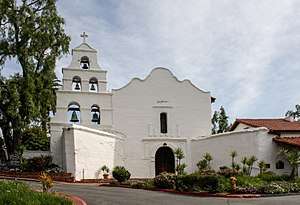 The church façade of Mission San Diego de Alcalá | |
 Location in San Diego | |
| Location |
10818 San Diego Mission Rd. San Diego, California 92108-2429 |
|---|---|
| Coordinates | 32°47′4″N 117°6′23″W / 32.78444°N 117.10639°WCoordinates: 32°47′4″N 117°6′23″W / 32.78444°N 117.10639°W |
| Name as founded | La Misión San Diego de Alcalá[1] |
| English translation | The Mission of Saint Didacus of Acalá[2] |
| Patron | Saint Didacus of Alcalá[1] |
| Nickname(s) | "Mother of the Alta California Missions"[3] |
| Founding date | July 16, 1769[4] |
| Founding priest(s) | Father Presidente Junípero Serra [5] |
| Built | 1769 |
| Architect | Fr. Jose Bernardo Sanchez |
| Founding Order | First[2] |
| Headquarters of the Alta California Mission System | 1769–1771[6] |
| Military district | First[7][8] |
| Native tribe(s) Spanish name(s) |
Kumeyaay (Ipai / Tipai)[4] Diegueño[4] |
| Native place name(s) | Kosoi, Nipawai[9] |
| Baptisms | 6,522[10] |
| Confirmations | 1,379[11] |
| Marriages | 1,794[10] |
| Burials | 4,322[10] |
| Neophyte population | 1,455[10][12] |
| Secularized | 1834[2] |
| Returned to the Church | 1862[2] |
| Governing body | Roman Catholic Diocese of San Diego |
| Current use | Parish Church |
| Official name: San Diego Mission Church | |
| Designated | April 15, 1970[13] |
| Reference no. | 70000144[13] |
| Designated | April 15, 1970[14] |
| Reference no. | #242 |
| Designated | October 6, 1976[15] |
| Reference no. | 113 |
| Website | |
| http://missionsandiego.com | |
Mission Basilica San Diego de Alcalá was the first Franciscan mission in The Californias, a province of New Spain. Located in present-day San Diego, California, it was founded on July 16, 1769, by Spanish friar Junípero Serra in an area long inhabited by the Kumeyaay people. The mission and the surrounding area were named for the Catholic Didacus of Alcalá, a Spaniard more commonly known as San Diego. The mission was the site of the first Christian burial in Alta California. San Diego is also generally regarded as the site of the region's first public execution, in 1778. Father Luis Jayme, California's first Christian martyr, lies entombed beneath the chancel floor. The current church, built in the early 19th century, is the fifth to stand on this location.[16][17] The mission site is a National Historic Landmark.[14][18]
History
The former Spanish settlement at the Kumeyaay Nipawai lies within that area occupied during the late Paleoindian period and continuing on into the present day by the Native society commonly known as the Diegueño;[19] the name denotes those people who were ministered by the padres at Mission San Diego de Alcalá.[20] Relatively, much is known about the native inhabitants in recent centuries, thanks in part to the efforts of the Spanish explorer Juan Rodríguez Cabrillo, who documented his observations of life in the coastal villages he encountered along the Southern California coast in October 1542.[21] Cabrillo, a Portuguese navigator in the service of Spain, is credited as the first European to encounter San Diego Bay. On the evening of September 28, 1542, the ships San Salvador and Victoria sailed into the harbor, whereupon Cabrillo christened it "San Miguel."[22] During that expedition a landing party went ashore and briefly interacted with a small group of natives. Some sixty years later another Spanish explorer, Sebastián Vizcaíno, made landfall some ten miles from the present Mission site. Under Vizcaíno's command the San Diego, Santo Tomás, and frigate Tres Reyes dropped anchor on November 10, 1602, and the port was renamed "San Diego de Alcalá."[23][24] It would be another 167 years before the Spanish returned to San Diego. Ever since the voyages of Christopher Columbus, the Kingdom of Spain sought to establish missions to convert the pagans in Nueva España ("New Spain") to Roman Catholicism to save souls and to facilitate colonization of these lands. However, it was not until 1741—the time of the Vitus Bering expedition, when the territorial ambitions of Tsarist Russia towards North America became known—that King Philip V felt such installations were necessary in Upper California.[25]
In 1769, Visitador General José de Gálvez sent the expedition of Junípero Serra and Gaspar de Portolà to found missions and presidios at San Diego and Monterey (see Timeline of the Portolà expedition), thereby securing Spain's claim to the Pacific Coast harbors recommended by Cabrillo and Vizcaino.[26] Two groups traveled from Lower California on foot, while a pair of packet ships (bearing supplies) traveled up the coast from the Baja California Peninsula.[27][28]
Rancho period (1834–1849)
On August 9, 1834, Governor Figueroa issued his "Decree of Confiscation."[29] The missions were offered for sale to citizens, who were unable to come up with the price, so all mission property was broken up into ranchos and given to ex-military officers who had fought in the War of Independence against Spain. On June 8, 1846, Mission San Diego de Alcalá was given to Santiago Argüello by Governor Pío Pico "...for services rendered to the government."[30] After the United States annexed California, the Mission was used by the military from 1846 to 1862.

California statehood (1850–1900)
President Abraham Lincoln signed a proclamation on May 23, 1862, that restored ownership of the Mission proper to the Roman Catholic Church.[31][32] When Mission San Diego de Alcalá was granted back to the Church, it was in ruins. In the 1880s Father Anthony Ubach began to restore the old Mission buildings.
20th century and beyond (1901 – present)
Father Ubach died in 1907 and restoration work ceased until 1931. In 1941, the Mission once again became a parish church, in what is still an active parish serving the Diocese of San Diego. In 1976, Pope Paul VI designated the Mission church as a minor basilica.[18]
Mission San Diego de Alcalá is located within San Diego city limits, near the intersection of Interstate 8 and Interstate 15, and approximately one mile east of Qualcomm Stadium. The parish is partially funded by a gift shop, and self-guided tours of the grounds and buildings are available to the public for a small donation.
Other historic designations
- California Historical Landmark #242
- California Historical Landmark #784 – El Camino Real (starting point in Alta California)
- City of San Diego Historic Designation #113
Mission industries

The goal of the missions was, above all, to become self-sufficient in relatively short order. Farming, therefore, was the most important industry of any mission. Prior to the establishment of the missions, the native peoples knew only how to utilize bone, seashells, stone, and wood for building, tool making, weapons, and so forth. The missionaries discovered that the Indians, who regarded labor as degrading to men, had to be taught industry in order to learn how to be self-supportive. The result was the establishment of a great manual training school that comprised agriculture, the mechanical arts, and the raising and care of livestock. Everything consumed and otherwise utilized by the natives was produced at the missions under the supervision of the padres; thus, the neophytes not only supported themselves, but after 1811 sustained the entire military and civil government of California.[34] Wheat, corn, wine grapes, barley, beans, cattle, horses, and sheep were the major crops at San Diego. In 1795, construction on a system of aqueducts was begun to bring water to the fields and the Mission (the first irrigation project in Upper California).[35] The building manager was Fray Pedro Panto, who was poisoned by his Indian cook Nazario before the project was completed.[36] In his testimony, in the trial that followed, Nazario stated that he had poisoned the friar due to constant beatings inflicted by Friar Panto.[37]
The Mission San Diego was primarily supported from lands included in a Spanish royal land grant, encompassing roughly the eastern third of the current City of San Diego, as well as most of the cities of La Mesa and Lemon Grove. While not exact, its boundaries are roughly Interstate 805, Miramar Road, Route 125 (California), Skyline Drive and Division Street. Boundary Street (which parallels Interstate 805 in the neighborhood of North Park) lies directly on one portion of the boundary and draws its name from it.
Wine
The first vineyards planted in California were planted at the mission in 1769.[38] Father Junípero Serra planted these initial vines.[39] The vines were of the Mission variety, which were brought to Mexico in the 16th Century.[40] Unfortunately, the initial plantings did not survive, with Mission San Juan Capistrano having the first surviving plantings.[41] By at least 1781, wine was being produced at the mission.[42] One source claims that the vineyard on mission lands reached up to fifty thousand acres.[43] The mission vineyards were around until at least 1823.[44]
Mission bells
Bells were vitally important to daily life at any mission. The bells were rung at mealtimes, to call the Mission residents to work and to religious services, during births and funerals, to signal the approach of a ship or returning missionary, and at other times; novices were instructed in the intricate rituals associated with ringing the mission bells. This mission had five bells.
See also
Notes
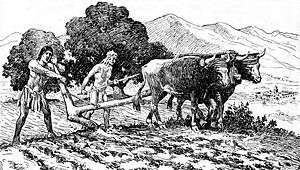
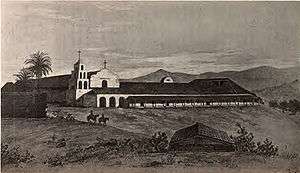
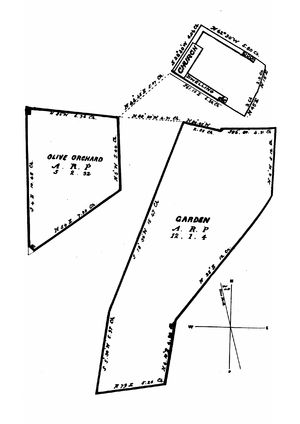

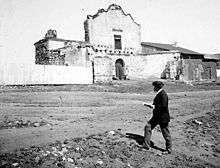
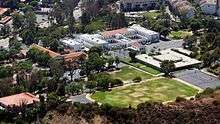
- 1 2 Leffingwell, p. 17
- 1 2 3 4 Krell, p. 71
- ↑ Young, p. 14
- 1 2 3 Yenne, p. 24
- ↑ Ruscin, p. 196
- ↑ Yenne, p. 186
- ↑ Forbes, p. 202
- ↑ Engelhardt 1920, pp. v, 228 "The military district of San Diego embraced the Missions of San Diego, San Luis Rey, San Juan Capistrano, and San Gabriel..."
- ↑ Ruscin, p. 195
- 1 2 3 4 Krell, p. 315: as of December 31, 1832; information adapted from Engelhardt's Missions and Missionaries of California.
- ↑ Engelhardt 1920, pp. 300–301: as of December 31, 1832. An additional 426 confirmations were performed between January 1, 1833 and December 31, 1841.
- ↑ Engelhardt 1920, pp. 300–301. 1824 saw the greatest number of neophytes attached to the Mission (1,829), whereas the smallest recorded neophyte population was ninety seven neophyte. It was seen in 1774.
- 1 2 National Park Service (2010-07-09). "National Register Information System". National Register of Historic Places. National Park Service.
- 1 2 "San Diego Mission Church". National Historic Landmark summary listing. National Park Service. Archived from the original on 2009-02-14. Retrieved 2009-08-24.
- ↑ "Historical Landmarks Designated by the San Diego Historical Resources Board" (PDF). City of San Diego.
- ↑ Snell, Charles (September 4, 1976). "San Diego Mission Church" (pdf). National Register of Historic Places – Inventory Nomination Form. National Park Service. Retrieved 22 May 2012.
- ↑ "San Diego Mission Church" (pdf). Photographs. National Park Service. Retrieved 22 May 2012.
- 1 2 "Questions & Answers - Mission Basilica San Diego de Alcalá". Mission Basilica San Diego de Alcalá. Retrieved 2018-08-27.
- ↑ Kroeber 1925, p. 883: Kroeber estimated that the native population in the immediate vicinity of San Diego was approximately 3,000 in 1770 (exclusive of those in Baja California).
- ↑ As with other Spanish names given to the indigenous tribes they encountered arthas, the appellation Diegueño does not necessarily identify a specific ethnic or tribal group.
- ↑ Yenne, p. 8
- ↑ Engelhardt 1920, p. 3: September 28 was the eve of the "Feast of the Archangel Saint Michael."
- ↑ Engelhardt 1920, pp. 6–9: November 10 was the eve of "St. Martin's Day".
- ↑ Davidson, p. 2: "Sebastian Vizcaino, entering November 11–12, 1602, first applied the name San Diego de Alcalá to this port."
- ↑ Morrison, p. 214
- ↑ Yenne, p. 10
- ↑ Engelhardt 1920, p. 9
- ↑ Yenne, p. 10: In January 1769 the San Carlos departed Baya de San Barnabé, followed a month later by the San Antonio, which sailed out of Cabo San Lucas. A third vessel, the San José, left New Spain later that spring but was lost at sea.
- ↑ Engelhardt 1922, p. 114
- ↑ Leffingwell, p. 19
- 1 2 Engelhardt 1920, p. 348
- ↑ Robinson, pp. 31–32: Patents for each mission were issued to Archbishop J.S. Alemany based on his claim filed with the Public Land Commission on February 19, 1853.
- ↑ Engelhardt 1920, p. 223. From the '"California Archives, State Papers, Missions, vol. vi, p. 180.
- ↑ Engelhardt 1922, p. 211
- ↑ Hall, William Hammond (1888). Irrigation in California (Southern): The Field, Water-supply, and Works, Organization and Operation in San Diego, San Bernardino, and Los Angeles Counties. California. Office of State Engineer. p. 85. Retrieved 14 July 2012.
- ↑ Smythe, William Ellsworth (1907). History of San Diego, 1542–1907: An Account of the Rise and Progress of the Pioneer Settlement on the Pacific Coast of the United States. History Company. p. 77. Retrieved 14 July 2012.
- ↑ McCormack, Brian T. (2007-01-01). "Conjugal Violence, Sex, Sin, and Murder in the Mission Communities of Alta California". Journal of the History of Sexuality. 16 (3): 391–415. doi:10.1353/sex.2007.0070. ISSN 1535-3605.
- ↑ Dailey, Keli (29 August 2012). "Winery guide: San Diego County, uncorked". San Diego Union-Tribune. Retrieved 19 September 2017.
Never mind that the original Golden State vines broke ground at Mission San Diego de Alcalá in 1769 and became Father Junipero Serra’s Communion wine.
Richard Vine; Bruce Bordelon; Ellen M. Harkness; Theresa Browning (29 June 2013). Winemaking: From Grape Growing to Marketplace. Springer Science & Business Media. p. 10. ISBN 978-1-4757-2656-5.
Wycoff, Ann (23 September 2016). "The Ultimate San Diego Wine Guide". San Diego Magazine. Retrieved 21 September 2017. - ↑ Jean L. Jacobson (14 June 2006). Introduction to Wine Laboratory Practices and Procedures. Springer Science & Business Media. p. 85. ISBN 978-0-387-25120-2.
Ian S Hornsey (9 October 2015). The Chemistry and Biology of Winemaking. Royal Society of Chemistry. p. 55. ISBN 978-1-78262-631-2.
LaMar, Jim (25 August 2002). "Mission". Professional Friends of Wine. Retrieved 21 September 2017.More than a century later, Franciscan monk Junipero Serra first planted the Mission variety in California, at Mission San Diego, in 1769.
- ↑ "Mission". Calwineries Inc. Retrieved 19 September 2017.
Spanish Missionaries first brought the grape to Mexico during the 16th century. The vines that Father Juniper Serra planted at Mission San Diego in 1769 probably descended from these original grapes.
- ↑ Charles L. Sullivan (1 October 1998). A Companion to California Wine: An Encyclopedia of Wine and Winemaking from the Mission Period to the Present. University of California Press. p. 218. ISBN 978-0-520-92087-3.
- ↑ Dwight Furrow; Lynn Furrow (22 November 2014). San Diego, Wine Country: A Tasting Guide. BookBaby. p. 91. ISBN 978-1-4835-4599-8.
- ↑ "The Winery". Social Studies Fact Cards. Toucan Valley Publications, Inc. Retrieved 19 September 2017.
Several missions became known for their wine. Mission San Diego had 50,000 acres of land planted in grapevines.
- ↑ Lynne Newell Christenson; Ellen L. Sweet (2008). Ranchos of San Diego County. Arcadia Publishing. p. 9. ISBN 978-0-7385-5965-0.
- ↑ Engelhardt 1920, p. 346
References
- Bancroft, Hubert Howe (1884–1880). History of California, vols. i–vii (1542–1890). The History Company, San Francisco, CA. Check date values in:
|year=(help) - Chapman, Charles E. (1921). A History of California; The Spanish Period. The MacMillan Company, New York, NY.
- Davidson, Winifred (January 1955). "San Diego in One Easy Lesson". The Journal of San Diego History. 1 (1): 2–3.
- Engelhardt, Zephyrin, O.F.M. (1920). San Diego Mission. James H. Barry Company, San Francisco, CA.
- Engelhardt, Zephyrin, O.F.M. (1922). San Juan Capistrano Mission. Standard Printing Co., Los Angeles, CA.
- Forbes, Alexander (1839). California: A History of Upper and Lower California. Smith, Elder and Co., Cornhill, London.
- Jones, Terry L. and Kathryn A. Klar (eds.) (2007). California Prehistory: Colonization, Culture, and Complexity. Altimira Press, Landham, MD. ISBN 0-7591-0872-2.
- Krell, Dorothy (ed.) (1979). The California Missions: A Pictorial History. Sunset Publishing Corporation, Menlo Park, CA. ISBN 0-376-05172-8.
- Leffingwell, Randy (2005). California Missions and Presidios: The History & Beauty of the Spanish Missions. Voyageur Press, Inc., Stillwater, MN. ISBN 0-89658-492-5.
- Morrison, Hugh (1987). Early American Architecture: From the First Colonial Settlements to the National Period. Dover Publications, New York, NY. ISBN 0-486-25492-5.
- Paddison, Joshua (ed.) (1999). A World Transformed: Firsthand Accounts of California Before the Gold Rush. Heyday Books, Berkeley, CA. ISBN 1-890771-13-9.
- Robinson, W.W. (1948). Land in California. University of California Press, Berkeley and Los Angeles, CA.
- Ruscin, Terry (1999). Mission Memoirs. Sunbelt Publications, San Diego, CA. ISBN 0-932653-30-8.
- Stern, Jean & Gerald J. Miller (1995). Romance of the Bells: The California Missions in Art. The Irvine Museum, Irvine, CA. ISBN 0-9635468-5-6.
- Yenne, Bill (2004). The Missions of California. Advantage Publishers Group, San Diego, CA. ISBN 1-59223-319-8.
- Young, Stanley & Melba Levick (1988). The Missions of California. Chronicle Books LLC, San Francisco, CA. ISBN 0-8118-3694-0.
External links
| Wikimedia Commons has media related to Mission San Diego de Alcalá. |
- Official Mission San Diego de Alcala website
- "Sociopolitical Aspects of the 1775 Revolt at Mission San Diego de Alcalá: an Ethnohistorical Approach" by Richard L. Carrico
- Spanish Wiki page with Fray Pedro Panto´s biography
- Early photographs, sketches of Mission San Diego de Alcala, via Calisphere, California Digital Library
- Early History of the California Coast, a National Park Service Discover Our Shared Heritage Travel Itinerary
- Listing, photographs, and drawings at the Historic American Buildings Survey
- Howser, Huell (December 8, 2000). "California Missions (101)". California Missions. Chapman University Huell Howser Archive.